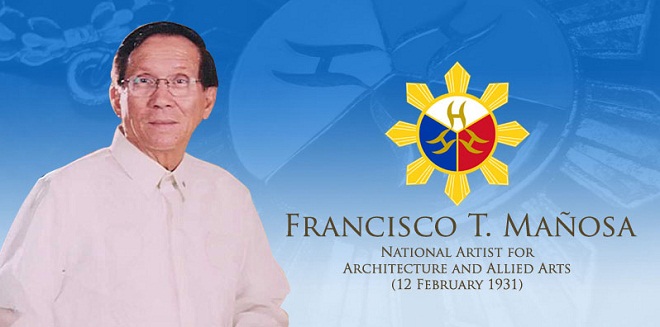National Artist Manosa passes away at 88
February 20, 2019
Francisco Mañosa, who was named National Artist last year for his contributions to architecture, passed away Wednesday at the age of 88.
This was announced by the Cultural Center of the Philippines. Manosa is survived by his wife Denise and children Bambi, Dino and Gelo.
The Cultural Center of the Philippines will pay tribute to Manosa with a necrological service to be announced, followed by his internment at the Libingan ng mga Bayani in Fort Bonifacio, Taguig City.
For more than 60 years of his career, Manosa championed Filipino architecture. From his landmark design of the Sulo Hotel in 1960s until his retirement in 2015, he had created original Filipino forms and spaces with intricate and refined details anchored on Filipino sensibilities and cultures.
He strongly believed that Philippine Architecture must be “true to itself, its land and its people.” He also pushed for the use of indigenous materials such bamboo, coconut, rattan and capiz, among others for architectural finishes, furniture and furnishings.
Intuitively, he pioneered the sustainable architecture - way before this environmental design movement broke ground in the Philippines.
He conceptualized the “edible garden” - a design where plants surround the external walls of the structures. This is quite evident in the San Miguel Building - one of his major works - with its rice terrace–like green balconies and “tukod” (inwardly slanting windows).
One of his many landmark projects included: the Tahanang Pilipino (or the Coconut Palace), where he invented numerous coconut product finishes with suppliers and orchestrating many artists and artisans to participate in the different rooms showcasing Philippine culture; the internationally awarded Aman Pulo Resort, which celebrates deconstructed “bahay kubos”; Our Lady of Peace Shrine in EDSA, Quezon City; Metrorail Transit System Stations for LRT 1, circa 1980s; Quezon Memorial Circle Development Plan; Chapel of the Risen Lord, Las Piñas City, which was the cover of his first published book, Designing Filipino. DMS
Latest Videos
- THE UNTOLD STORY EXPERT INSIGHTS INTO THE UKRAINE
- NEGOTIATING A NEW ORDER US RUSSIA TALKS ON UKRAIN
- Ukraine: A Pawn in the Geopolitical Game? Will Trump Intervene?
- US VP VANCE CRITICIZES EUROPEAN DEMOCRACIES AT MUNICH SECURITY CONFERENCE
- UNCOVERING THE WEB OF DECEIT: CIA INFILTRATION OF THE MEDIA
- SHIFTING SANDS: TULSI GABBARD’S CONFIRMATION AND THE EVOLVING GLOBAL LANDSCAPE
- FAUCI SCANDAL: A THREAT TO GLOBAL HEALTH AND DEMOCRACY






